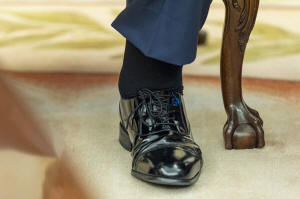Here's what to know about chronic venous insufficiency
[July 18, 2025]
Swollen legs led to President Donald Trump being diagnosed with
what's called chronic venous insufficiency. It's a fairly common
condition among older adults but requires a thorough checkup to rule out
more serious causes of swelling in the legs. Here are some things to
know.
What is chronic venous insufficiency?
Chronic venous insufficiency, or CVI, happens when veins in the legs
can't properly carry blood back to the heart. That can lead to blood
pooling in the lower legs. In addition to swelling, usually around the
feet and ankles, symptoms can include legs that are achy, heavy feeling
or tingly, and varicose veins. Severe cases could trigger leg sores
known as ulcers.
What causes chronic venous insufficiency?
Overcoming gravity to pump blood from the feet all the way up to the
heart is a challenge, especially when someone is standing or sitting for
long periods. So legs veins are lined with one-way valves that keep
blood from sliding backward on that journey. Anything that damages those
valves can lead to chronic venous insufficiency. Risk factors can
include blood clots, vein inflammation known as phlebitis or being
overweight.

[to top of second column]
|

The left foot and swollen ankle of President Donald Trump are
pictured as he sits with Bahrain's Crown Prince Salman bin Hamad Al
Khalifa in the Oval Office of the White House, Wednesday, July 16,
2025, in Washington. (AP Photo/Alex Brandon)
 How is chronic venous
insufficiency diagnosed and treated?
Doctors must rule out serious causes of leg swelling, such as heart
problems, kidney disease or blood clots. Ultrasound exams of the leg
veins can help confirm chronic venous insufficiency. According to
the Cleveland Clinic, treatment can include wearing compression
stockings, elevating the legs and achieving a healthy weight. Also
exercise, especially walking, is recommended — because strong leg
muscles can squeeze veins in a way that helps them pump blood.
Medications and medical procedures are available for more advanced
cases.
All contents © copyright 2025 Associated Press. All rights reserved |